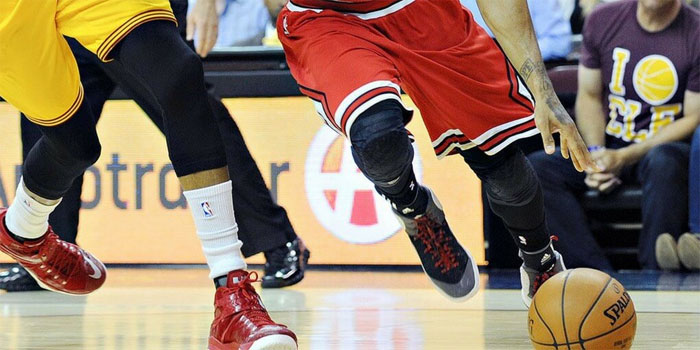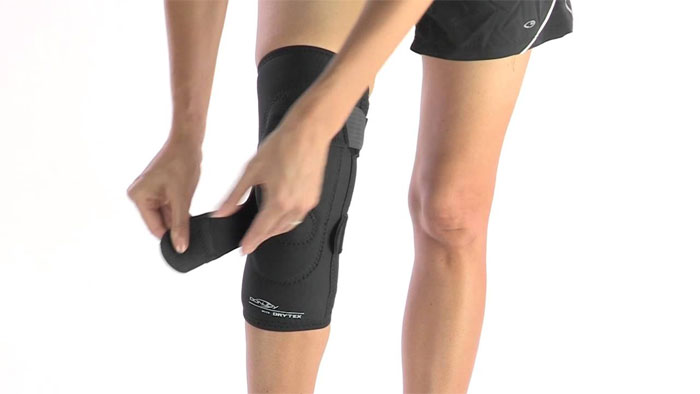Knee injuries are an unfortunate part of life. Even if you don't play sports or have an active lifestyle, you can incur knee injuries and pain.
When you get a knee injury, you'll likely need to wear a knee brace to stabilize the joint and promote healing. Knee braces are a typical natural and inexpensive treatment for knee pain.
However, people are usually very eager to get them taken off to be on their way to the next phase of recovery.
You may be wondering, “How long should I wear a knee brace?” In this article, we'll give you a rough estimate of how long you'll be in your brace and how you can speed up healing time.
Types of Knee Brace
A knee brace is a support device you wear for a painful or injured knee. Many people use them to prevent injuries during sports.
Others who don't play sports use them to stabilize the joint and prevent the knee from dislocating.

Braces can come in several materials and colors, such as metal, foam, elastic, and more. There are four main types of knee braces:
- Prophylactic — Designed to prevent injuries to knees during contact sports, such as basketball.
- Functional — Give support to knees that are already injured.
- Rehabilitative — Limit the knee's movement while it's healing after an injury or surgery.
- Patellofemoral — Help the kneecap move over the knee joint.
Knee compression sleeves, though not technically braces, are the most common type of knee support. They are elastic sleeves that go over the knee and provide compression around the joint, which helps support the knee and reduce swelling.
Depending on your situation, your doctor may recommend a specific type of knee brace. They will also recommend that you wear it for a specified time for the best results.
If you have an injury, but you did not go to a doctor for it, you will probably wonder how long you should wear your brace. We will go over this situation in the next section.
How Long Should I Wear My Knee Brace?
How long you should wear your brace depends on your situation. Regardless of whether you self-diagnose your injury or if you have a doctor diagnose you, you should wear your brace for at least a week.
This gives the brace time to do its job and stabilize the joint while it heals.

The type of injury also affects how long you should wear a knee brace. For instance, a minor sprain will require less time in a brace than a major dislocation or surgery.
We strongly recommend going to a doctor to get an accurate gauge for how long you should wear a knee brace. However, if this is not possible, we recommend the following:
- Wear your knee brace for at least a week to promote stabilization and healing.
- For minor injuries, you can usually take the brace off after about ten days. Make sure swelling and pain are not present.
- For moderate injuries, you should wear the fitting for 2-4 weeks. Only take the brace off if pain and swelling are not present, and you can move your knee freely without the brace.
- For severe injuries, we strongly recommend seeing a doctor and getting an accurate period. Injuries like these, where you must immobilize your knee to heal, are serious.
How To Wear Your Knee Brace Properly
At best, knee braces can be an uncomfortable inconvenience if you wear them incorrectly.
At worst, they can cause quite a bit of pain. You must know how to wear your knee brace correctly to get the best use out of it.
Doctors typically prescribe rehabilitative and patellofemoral braces. These limit or improve the motion of your knee joint. If you need one of these complex braces, your doctor will go over the specifics of how and when to wear it.
The other two types, prophylactic and functional braces, are the two most common knee braces for athletes and come with less restrictions. In most cases, you will not need to wear these braces 24/7.
However, you will need to learn when it's best to wear the brace and what movements you should restrict to get the best results.

The Dangers of an Improperly Worn Brace
Braces that are too tight can create problems for you. They can cut off the circulation to your leg or even pinch nerves in the leg. Pinched nerves or reduced circulation to the leg can lead to discoloration, swelling, numbness, and tingling in the leg.
On the flip side, if your brace is too loose, it will not provide enough support for the knee to heal.
How to Ensure Your Brace is Properly Sized and Fitted
Check the sizing chart that comes with your brace. If you're getting a brace at the doctors' office, your doctor will ensure that it fits correctly. If you're purchasing it from a health store, always check the sizing chart before you buy.
Use a tape measure to measure the girth of your knee at the joint, then check the chart to choose the correct size. If you can, try on the brace before buying, so you can feel how tight or loose it is.
Once you have your brace on your leg, walk around a bit and see how it feels. If it's too loose, it'll slide down your knee and provide no support. If it's too tight, your leg may feel numb or tingly.
When the size is just right, it'll provide compression and support to your knee joint without sliding or falling.
Do I Have to Wear A Knee Brace 24/7?
Talk to your doctor to discuss whether wearing your brace all day is right for you. If your doctor recommends it, you can wear the brace all day.
Here are some situations that you'll also want to discuss with your doctor to determine if you need to wear your brace or not.
Do I have to wear the knee brace while sleeping?
If your doctor tells you to wear the support 24/7, you'll need to wear it while you sleep. If it fits properly, you should have no issues with circulation or pain, and it should be comfortable.
Regardless of if you sleep with the support on or off, here are some tips for sleeping:
- Sleep on your back and use pillows as support for your knee.
- Use ice before you go to bed to reduce inflammation and swelling.
- Apply lotion to your leg before bed. Braces can make your leg itchy and dry, so make sure to moisturize.
Can I wear the knee brace with pants?
Yes. You can wear the fitting with pants either underneath or over the fabric.
If you're wearing jeans that are too skinny for the brace to fit under, put it over. Ensure that the brace is snug enough to do its job, even if you're wearing it over pants.
If you decide to put it on under your pants, make sure the pants are loose enough not to rip or tear.
Can I wear the knee brace in the shower?
If you get the go-ahead from your doctor to take the fitting off while you shower, you may.
However, be careful not to put too much weight on the affected leg while your brace is off. You must also ensure that your leg is completely dry before putting the brace back on.
If you cannot take your brace off, carefully wrap it in a plastic bag to prevent it from getting wet.
How Long Should I Wear A Knee Brace After ACL Surgery?
Tearing your ACL is a common injury that happens to athletes, especially basketball, football, and soccer.
If you tear your ACL, you will need to see a doctor, who will more than likely do a surgical repair and recommend a knee brace during your recovery.
The type of ACL injury determines how long you'll need to wear the brace:
- First-degree ACL tears are not tears; the ACL has just stretched. With first-degree tears, you'll have some mild tenderness and swelling. However, you'll still be able to put weight on the joint, stand, and walk. We recommend wearing a brace for 1-2 weeks while the joint heals on its own.
- Second-degree tears are more serious, in which the ACL is partially torn. You'll experience moderate swelling and tenderness with pain when you walk. Second-degree tears are a medical emergency; you may not need surgery, but your physician will likely recommend a brace for at least 1-2 months.
- Third-degree tears are full-on torn ligaments with a lot of pain and swelling. You will not be able to hold your knee in place at all, so you will not be able to walk or stand. A completely torn ACL requires surgery and several months in a knee brace. Your physician will let you know exactly how long you'll need to stabilize or immobilize your knee. Typically, you'll spend between six and nine months recovering from this type of severe injury.
How Long Should I Wear A Knee Brace Post-Meniscus Surgery?
The ACL is not the only part of the knee that can get injured; you can also injure your meniscus. The meniscus refers to two pieces of cartilage between the tibia and femur.
If you've torn your meniscus, you will likely require surgery to repair it. Then, your doctor will recommend you stabilize the joint to promote healing.
Minor to moderate meniscus injuries will require a basic knee sleeve. You can typically purchase these at drugstores. Severe meniscus injuries will require ligament or hinged braces, which often must be prescribed by a doctor.
Regardless of the severity, most doctors recommend you stay in a brace for at least six weeks while your bones and ligaments heal from the surgery.
Conclusion: How Long Should I Wear A Knee Brace?
The length of time that you should wear one depends on the type and severity of your injury.
Generally speaking, less severe injuries will require less time in a brace, and more severe injuries will require more time. A first-degree torn ACL may only require a compression sleeve, but a full-on torn meniscus will require a much more complex contraption.
If you're still unsure about what brace to purchase or how long to wear it, talk to a doctor or physician.
Ask them if you need the knee brace, what kind is appropriate for your injury, and what you can do to encourage healing. Doctors and physicians are always willing to help you find out what you need to heal faster.
You might also like: How Long Can You Wear a Knee Compression Sleeve?
